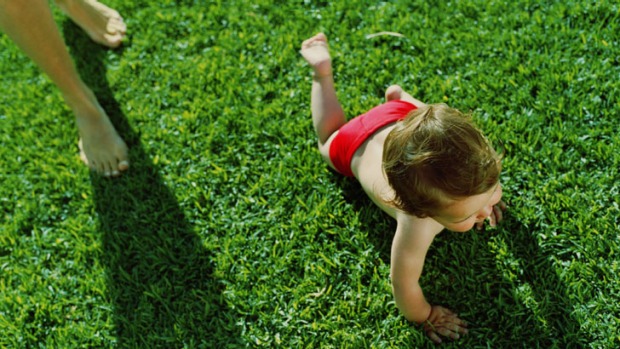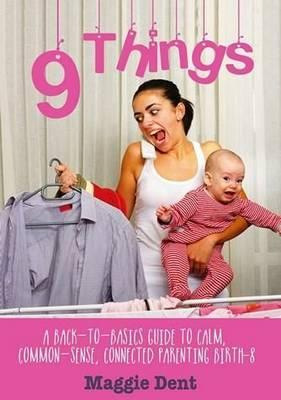
As parents we often can’t wait until our babies can crawl and then walk – and then we spend the rest of our time wishing we could find them or catch them.
Seeing our child able to move, whether it’s a commando crawl, a bum skid or a tummy roll, is a fabulous moment in our parenting journey.
But it’s much more than that, of course, as without plenty of natural movement, babies and toddlers run the risk of experiencing developmental delays in all areas of life.
Movement is not just about the physical body; it is a very sophisticated necessity for developing healthy brains, healthy minds and nurturing the socio-cultural development of every human being. As parents, we need to be wary of passivity and a lack of natural movement for our kids.
So why are we ‘containerising’ many of today’s children in ways that prevent them from moving?
Human beings were born to be movers, and living a sedentary life is really a disruption to our authentic nature.
Research shows that exercise and physical activity increase the levels of serotonin, norepinephrine and dopamine, which are crucial neurotransmitters that traffic thoughts and emotions throughout the body.
Essentially, exercise has a profound impact on cognitive abilities and mental health. Not only that, it makes the blood pump through the body and stimulates the brain to work more efficiently and soundly.
It is an interesting irony that the modern world is hell-bent on creating gadgets and equipment to improve our lives, yet they often end up making it hard for our children to do what they are biologically wired to do: to move in deeply encoded ways to ensure they gradually grow in all their competencies.
Take, for example, the capsules that keep our babies safe in cars. Of course they are a fabulous invention for protecting babies in case there is an accident. But while leaving your baby in the capsule for long periods of time once out of the car might seem convenient and harmless, it is not optimal for spinal development, as movement is severely restricted.
The primary early requirements of baby movement are ones that involve stretching the spine, as this ensures the baby will be able to practice primitive reflexes to enable proper and healthy growth.
One of the most disturbing trends in modern life is that babies, toddlers and children have less freedom to move naturally, and it can impact on their behaviour and capacity to learn. So many products stop babies and toddlers from moving naturally and without restraint.
Think of walkers, prams, high chairs, bouncing gyms and plastic seats that can hold babies who are developmentally unable to sit by themselves. When we combine these contraptions with very little free movement, especially time on the floor, we may be creating unnecessary inhibitors to optimal baby and toddler development.
These containers are convenient for parents, but they also need to be seen through the lens of early child development, and maybe used less rather than more.
It can cause stress for babies, toddlers and infants to be restricted rather than being free to move, so it’s important to remember to relax, sit on the couch and simply watch your baby or toddler interact with the real world through the magic of movement in their own time and in their own way.
Children learn best by moving and doing, and this means they will often be noisy, untidy, messy and unpredictable.
Yes, sometimes life with little ones can feel boring and repetitive, but that’s okay. Without enough spinning, tumbling, balancing and rolling, toddlers and infants can run the risk of an under-developed cerebellum, which can feature in many children with attention issues and learning difficulties, particularly reading difficulties.
Many paediatric physiotherapists and OTs I’ve met also express concern at the increasing numbers of young preschool children with serious posture problems and chronic back pain.
They believe a combination of hours engaged with hand-held devices, plus an absence of climbing or hanging by their body weight on trees and monkey bars, are mainly to blame.
Movement skills have also been shown to contribute to improving literacy skills, concentration spans and the ability of children to shift their attention at will. Poor self-regulation is contributing to much of the restless, inappropriate behaviour we see in early years and primary school classes.
One other thing that has changed in childhood has been the freedom of children to move and play in bare feet.
Yes, there are so many cute little shoes and footwear, but bare feet matter. The soles of our feet are very sensitive and intrinsically wired to our brain. Podiatrist Tracy Byrne, who specialises in podopaediatrics in London, believes that wearing shoes at too young an age can hamper a child’s walking and cerebral development.

“Toddlers keep their heads up more when they are walking barefoot. The feedback they get from the ground means there is less need to look down, which is what puts them off balance and causes them to fall down,” Byrne writes in The Guardian.
The benefit of letting our little ones move as much as possible in the early years – using all their senses, engaging in the real world, preferably outside – is that it will help them to grow up healthier, happier, stronger, smarter, calmer and more capable.
So move baby, move, and don’t stop.
Maggie Dent is a parenting author, educator, speaker and mother of four sons. Her latest book, 9 Things: A back-to-basics guide to calm, commonsense, connected parenting birth–8 is in stores. See more at maggiedent.com.